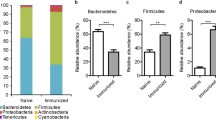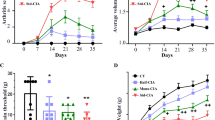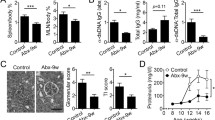Abstract
The profound influence of gut flora on host immune system and its link with autoimmune disorders have been established. However, the role of certain antibiotic in progression of autoimmune disorder is still confusing. Here, we employed a collagen-induced arthritis (CIA) model to explore the role of clindamycin administration in different scenarios. In the first scenario, mice treated with antibiotics for 4 weeks were performed with the induction of CIA immediately. The results showed that clindamycin administration promoted the incidence and severity of CIA, while the recipients of vancomycin showed completed tolerance. We also found that increased gut-associated Th1 and Th17 cells might be related to the subsequent expansion of collagen-specific immune response. In the second scenario, mice treated with antibiotics for 4 weeks were performed with CIA induction 4 weeks later. Notably, clindamycin administration showed a prolonged impact on the incidence and severity of CIA, as well as the gut immunity as compared to vancomycin administration. In addition, antibody depletion of integrin α4β7 systemically resulted in an impaired CIA response, underlining the influence of gut immunity. In the mice that received clindamycin, the abundance of anaerobic bacteria was significantly decreased and showed little recovery at 4 weeks later. Our observations highlighted the different characteristics of antibiotic administration on the development of autoimmune disorders and indicated its link with gut immunity.






Similar content being viewed by others
References
Harris, E.D., Jr. 1990. Rheumatoid arthritis. Pathophysiology and implications for therapy. The New England Journal of Medicine 322 (18): 1277–1289. https://doi.org/10.1056/NEJM199005033221805.
Feldmann, M., F.M. Brennan, and R.N. Maini. 1996. Rheumatoid arthritis. Cell. 85 (3): 307–310.
Brennan, F.M., and I.B. McInnes. 2008. Evidence that cytokines play a role in rheumatoid arthritis. The Journal of Clinical Investigation. 118 (11): 3537–3545. https://doi.org/10.1172/JCI36389.
Firestein, G.S., and I.B. McInnes. 2017. Immunopathogenesis of Rheumatoid Arthritis. Immunity. 46 (2): 183–196. https://doi.org/10.1016/j.immuni.2017.02.006.
Hasunuma, T., K. Nishioka, and K. Nishioka. 1997. Microorganisms in chronic arthritis. Lancet. 350 (9071): 145. https://doi.org/10.1016/S0140-6736(05)61852-1.
Zhang, X., D. Zhang, H. Jia, Q. Feng, D. Wang, D. Liang, et al. 2015. The oral and gut microbiomes are perturbed in rheumatoid arthritis and partly normalized after treatment. Nature Medicine 21 (8): 895–905. https://doi.org/10.1038/nm.3914.
Wu, H.J., I.I. Ivanov, J. Darce, K. Hattori, T. Shima, Y. Umesaki, et al. 2010. Gut-residing segmented filamentous bacteria drive autoimmune arthritis via T helper 17 cells. Immunity. 32 (6): 815–827. https://doi.org/10.1016/j.immuni.2010.06.001.
Hooper, L.V., D.R. Littman, and A.J. Macpherson. 2012. Interactions between the microbiota and the immune system. Science. 336 (6086): 1268–1273. https://doi.org/10.1126/science.1223490.
Sallusto, F. 2016. Heterogeneity of Human CD4(+) T Cells Against Microbes. Annual Review of Immunology. 34: 317–334. https://doi.org/10.1146/annurev-immunol-032414-112,056.
Tanoue, T., K. Atarashi, and K. Honda. 2016. Development and maintenance of intestinal regulatory T cells. Nature reviews Immunology. 16 (5): 295–309. https://doi.org/10.1038/nri.2016.36.
Strzepa, A., M. Majewska-Szczepanik, F.M. Lobo, L. Wen, and M. Szczepanik. 2017. Broad spectrum antibiotic enrofloxacin modulates contact sensitivity through gut microbiota in a murine model. The Journal of Allergy and Clinical Immunology. 140 (1): 121–133 e3. https://doi.org/10.1016/j.jaci.2016.11.052.
Dorozynska, I., M. Majewska-Szczepanik, K. Marcinska, and M. Szczepanik. 2014. Partial depletion of natural gut flora by antibiotic aggravates collagen-induced arthritis (CIA) in mice. Pharmacological Reports 66 (2): 250–255. https://doi.org/10.1016/j.pharep.2013.09.007.
Yurkovetskiy, L., M. Burrows, A.A. Khan, L. Graham, P. Volchkov, L. Becker, et al. 2013. Gender bias in autoimmunity is influenced by microbiota. Immunity. 39 (2): 400–412. https://doi.org/10.1016/j.immuni.2013.08.013.
Daum, R.S. 2007. Clinical practice. Skin and soft-tissue infections caused by methicillin-resistant Staphylococcus aureus. The New England Journal of Medicine. 357 (4): 380–390. https://doi.org/10.1056/NEJMcp070747.
Robinson, C.J., and V.B. Young. 2010. Antibiotic administration alters the community structure of the gastrointestinal micobiota. Gut Microbes. 1 (4): 279–284. https://doi.org/10.4161/gmic.1.4.12614.
Jernberg, C., S. Lofmark, C. Edlund, and J.K. Jansson. 2007. Long-term ecological impacts of antibiotic administration on the human intestinal microbiota. The ISME Journal. 1 (1): 56–66. https://doi.org/10.1038/ismej.2007.3.
Bach, J.F. 2018. The hygiene hypothesis in autoimmunity: the role of pathogens and commensals. Nature Reviews Immunology. 18 (2): 105–120. https://doi.org/10.1038/nri.2017.111.
Baumler, A.J., and V. Sperandio. 2016. Interactions between the microbiota and pathogenic bacteria in the gut. Nature. 535 (7610): 85–93. https://doi.org/10.1038/nature18849.
Berer, K., and G. Krishnamoorthy. 2012. Commensal gut flora and brain autoimmunity: a love or hate affair? Acta Neuropathologica. 123 (5): 639–651. https://doi.org/10.1007/s00401-012-0949-9.
Cremonesi, E., V. Governa, J.F.G. Garzon, V. Mele, F. Amicarella, M.G. Muraro, et al. 2018. Gut microbiota modulate T cell trafficking into human colorectal cancer. Gut. https://doi.org/10.1136/gutjnl-2016-313498.
Viladomiu, M., C. Kivolowitz, A. Abdulhamid, B. Dogan, D. Victorio, J.G. Castellanos, et al. 2017. IgA-coated E. coli enriched in Crohn’s disease spondyloarthritis promote TH17-dependent inflammation. Science Translational Medicine. 9 (376). https://doi.org/10.1126/scitranslmed.aaf9655.
Ivanov, I.I., K. Atarashi, N. Manel, E.L. Brodie, T. Shima, U. Karaoz, et al. 2009. Induction of intestinal Th17 cells by segmented filamentous bacteria. Cell. 139 (3): 485–498. https://doi.org/10.1016/j.cell.2009.09.033.
David, R. 2010. Regulatory T cells: A helping hand from Bacteroides fragilis. Nature Reviews Immunology. 10 (8): 539. https://doi.org/10.1038/nri2827.
Yang, Y., M.B. Torchinsky, M. Gobert, H. Xiong, M. Xu, J.L. Linehan, et al. 2014. Focused specificity of intestinal TH17 cells towards commensal bacterial antigens. Nature. 510 (7503): 152–156. https://doi.org/10.1038/nature13279.
Zaura, E., B.W. Brandt, M.J. Teixeira de Mattos, M.J. Buijs, M.P. Caspers, M.U. Rashid, et al. 2015. Same Exposure but Two Radically Different Responses to Antibiotics: Resilience of the Salivary Microbiome versus Long-Term Microbial Shifts in Feces. mBio. 6 (6): e01693–e01615. https://doi.org/10.1128/mBio.01693-15.
Sun, X., K. Winglee, R.Z. Gharaibeh, J. Gauthier, Z. He, P. Tripathi, et al. 2018. Microbiota-Derived Metabolic Factors Reduce Campylobacteriosis in Mice. Gastroenterology. https://doi.org/10.1053/j.gastro.2018.01.042.
Lemon, K.P., G.C. Armitage, D.A. Relman, and M.A. Fischbach. 2012. Microbiota-targeted therapies: an ecological perspective. Science Translational Medicine. 4 (137): 137rv5. https://doi.org/10.1126/scitranslmed.3004183.
Rashid, M.U., E. Zaura, M.J. Buijs, B.J. Keijser, W. Crielaard, C.E. Nord, et al. 2015. Determining the Long-term Effect of Antibiotic Administration on the Human Normal Intestinal Microbiota Using Culture and Pyrosequencing Methods. Clinical Infectious Diseases 60 (Suppl 2): S77–S84. https://doi.org/10.1093/cid/civ137.
Strzepa, A., M. Majewska-Szczepanik, P. Kowalczyk, D. Wozniak, S. Motyl, and M. Szczepanik. 2016. Oral treatment with enrofloxacin early in life promotes Th2-mediated immune response in mice. Pharmacological Reports 68 (1): 44–50. https://doi.org/10.1016/j.pharep.2015.07.002.
Cho, I., S. Yamanishi, L. Cox, B.A. Methe, J. Zavadil, K. Li, et al. 2012. Antibiotics in early life alter the murine colonic microbiome and adiposity. Nature. 488 (7413): 621–626. https://doi.org/10.1038/nature11400.
Sigmundsdottir, H., and E.C. Butcher. 2008. Environmental cues, dendritic cells and the programming of tissue-selective lymphocyte trafficking. Nature Immunology. 9 (9): 981–987. https://doi.org/10.1038/ni.f.208.
Mora, J.R., M.R. Bono, N. Manjunath, W. Weninger, L.L. Cavanagh, M. Rosemblatt, et al. 2003. Selective imprinting of gut-homing T cells by Peyer’s patch dendritic cells. Nature. 424 (6944): 88–93. https://doi.org/10.1038/nature01726.
Johansson-Lindbom, B., M. Svensson, O. Pabst, C. Palmqvist, G. Marquez, R. Forster, et al. 2005. Functional specialization of gut CD103+ dendritic cells in the regulation of tissue-selective T cell homing. The Journal of Experimental Medicine. 202 (8): 1063–1073. https://doi.org/10.1084/jem.20051100.
Author information
Authors and Affiliations
Corresponding author
Ethics declarations
Mice were housed in a specific pathogen-free environment and all the procedures were approved by the Ethics Committee of Guangdong Medical University.
Competing Interests
The authors declare that they have no competing interests.
Rights and permissions
About this article
Cite this article
Yang, S., Chen, H., Wei, B. et al. Clindamycin Administration Increases the Incidence of Collagen-Induced Arthritis in Mice Through the Prolonged Impact of Gut Immunity. Inflammation 41, 1900–1911 (2018). https://doi.org/10.1007/s10753-018-0833-4
Published:
Issue Date:
DOI: https://doi.org/10.1007/s10753-018-0833-4




